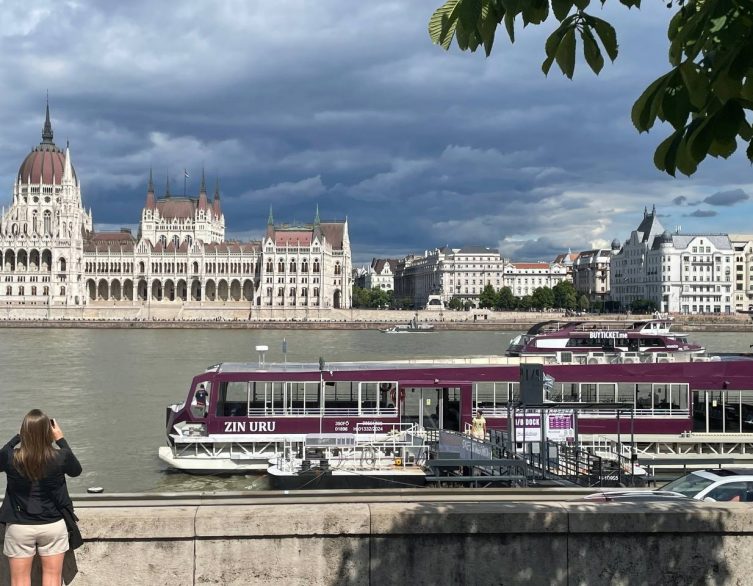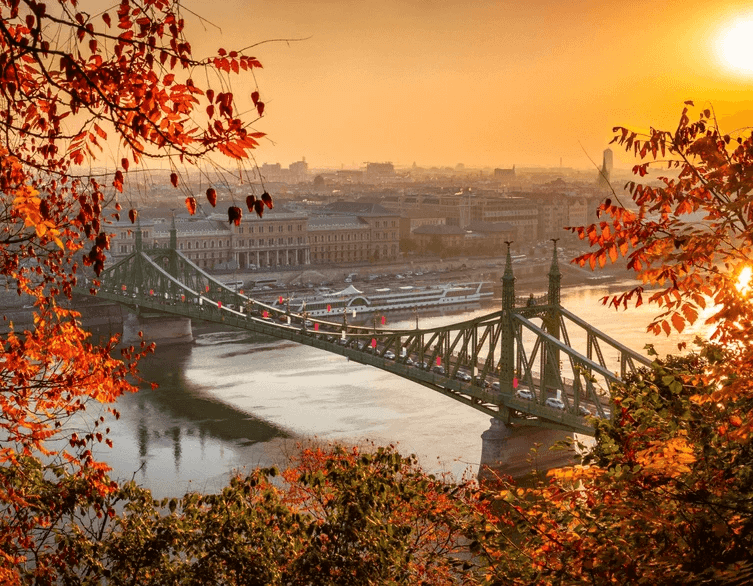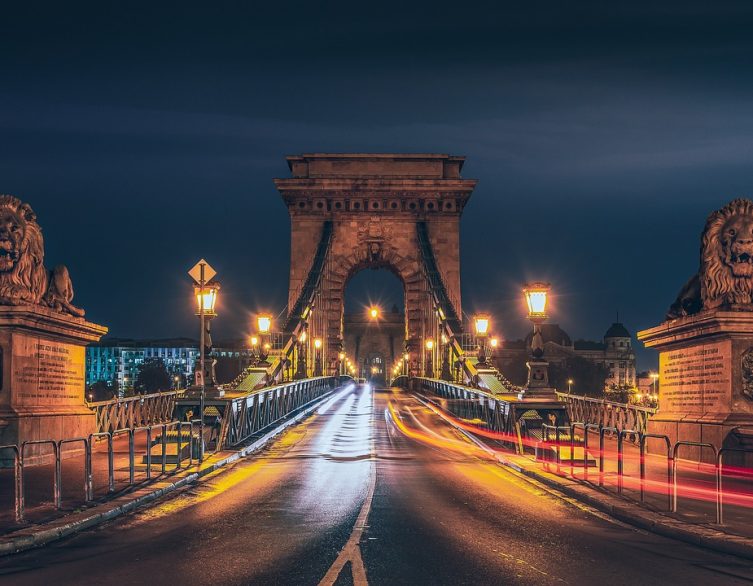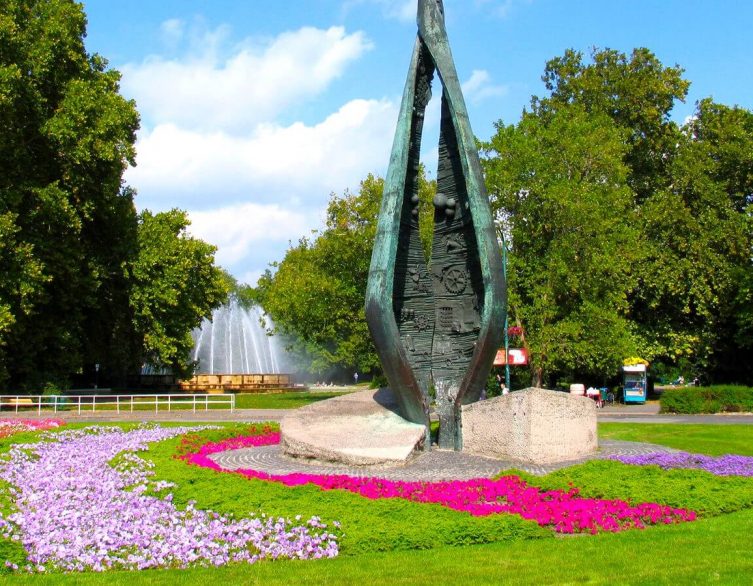The Bridges of Budapest: A Complete Guide to the Danube’s Most Beautiful Crossings

Budapest’s bridges are far more than mere transportation links – they are the city’s crown jewels, each telling a unique story of engineering prowess, historical significance, and architectural beauty. These magnificent structures span the mighty Danube River, connecting Buda and Pest while serving as iconic symbols of Hungary’s capital city.
Széchenyi Chain Bridge: The Pioneer of Permanent Connections
The Széchenyi Chain Bridge holds the distinguished honor of being Budapest’s first permanent bridge, forever changing the city’s landscape and destiny. Built between 1839 and 1849 according to William Tierney Clark’s designs, this 375-meter-long and 14.8-meter-wide masterpiece was initiated by Count István Széchenyi, whose vision transformed the way people crossed the Danube.
The bridge’s construction marked a pivotal moment in Budapest’s development, enabling year-round economic and social growth between the two sides of the city. The financing was arranged by Vienna banker Baron György Sina, who founded the Chain-bridge Share-holding Company. During World War II, retreating German forces destroyed this architectural treasure, but the resilient spirit of Budapest prevailed, and the bridge was reconstructed by 1949. Today, it stands as one of the city’s most important symbols, attracting thousands of tourists annually who come to capture its imposing beauty through countless photographs.
The bridge features massive chain links that give it its distinctive name, constructed from stone and cast iron in a stunning example of 19th-century engineering. Two imposing river piers anchor the structure, adorned with majestic lion sculptures at each end that were added in 1852. Despite urban legends suggesting otherwise, these lions do possess tongues, though they are not easily visible from ground level.
Megyeri Bridge: The Modern Marvel
Budapest’s newest and largest bridge, the Megyeri Bridge, represents the pinnacle of 21st-century engineering. Constructed between 2006 and 2008 based on designs by Pont-TERV Zrt., this impressive structure stretches 1,861 meters in length and spans 35 meters in width. As part of the M0 ring road system, the Megyeri Bridge serves the northern region’s traffic needs while significantly reducing congestion in the city center.
This modern cable-stayed bridge has quickly become a new symbol of Budapest, its spectacular structure showcasing the city’s commitment to contemporary infrastructure development while maintaining its historical charm.
Árpád Bridge: The Former Giant
Until the completion of the Megyeri Bridge in 2008, the Árpád Bridge held the title of Budapest’s longest bridge. Designed by Dr. Károly Széchy, this 928-meter-long structure with a width of 35.4 meters serves as one of the city’s most crucial transportation routes. The bridge provides direct access to Margaret Island and plays a vital role in relieving downtown traffic congestion, demonstrating the foresight of urban planners who recognized the need for a wide, robust crossing to accommodate the city’s growing vehicular demands.
Built in 1950 and connecting District III on the Buda side with District XIII on the Pest side, the Árpád Bridge represents post-war reconstruction efforts and modern urban planning.
Elizabeth Bridge: The Busiest Crossing
The Elizabeth Bridge stands as Budapest’s most heavily trafficked bridge, with hundreds of thousands of vehicles crossing it daily. Originally constructed between 1897 and 1903 based on August de Serres’ designs, the bridge underwent complete reconstruction between 1961 and 1964 following Pál Sávoly’s plans after the original chain bridge structure was destroyed in 1945.
Measuring 378.6 meters in length and 27.1 meters in width, with a main span of 290 meters making it Budapest’s highest bridge, the Elizabeth Bridge appears white from a distance but is actually light gray. An interesting cultural note: for many years, this bridge served as the opening logo for Hungarian Television, cementing its place in the nation’s visual identity. Named after Empress Elisabeth of Austria-Hungary (Sissi), the bridge connects District V in Pest with District I in Buda and offers direct access to Gellért Hill.
Best deals of Budapest
Margaret Bridge: The Long-Term Project
The Margaret Bridge represents one of Budapest’s most enduring construction stories, with work beginning in 1872-1876 based on Ernest Goüin’s designs, followed by expansion in 1935-1937, and comprehensive renovation in 2009-2011. This 607.6-meter-long and 25-meter-wide bridge has undergone multiple significant reconstructions, including major widening and renovation projects throughout its existence.
The bridge serves as a crucial connection between Margaret Island and both sides of the city, spanning from District XIII on the Pest side to District II on the Buda side. Its cultural significance extends beyond transportation – in 1877, János Arany wrote a ballad titled “Bridge Inauguration” about this structure, which was later illustrated by painter Mihály Zichy two decades later. The bridge features a characteristic bend at its middle that leads directly to Margaret Island, giving it a distinctive Parisian flavor with its exquisite, ornamental design and cast-iron railings.
Liberty Bridge: The Most Beautiful
Designed by engineer János Feketeházy, who created numerous other railway and road bridges throughout Hungary, the Liberty Bridge stands as Budapest’s most renowned and beautiful crossing. Construction began in 1894 and was completed within two years using modern technologies that made it cutting-edge for its era.
Originally named after Emperor Franz Joseph and opened to traffic in 1896, legend has it that the ruler himself drove in the final nail at the construction’s completion. The bridge measures 333.6 meters in length and 20.1 meters in width, featuring three main spans with the largest measuring 175 meters. Constructed from cast iron and steel, the bridge is easily recognizable by its unique green color and the Turul bird sculptures atop its pillars, representing symbols from Hungarian mythology.
Built for the 1896 millennium celebrations to provide faster transportation between the Danube’s banks, the bridge was destroyed by retreating German troops during World War II but was rebuilt by 1946. During summer months, the bridge frequently hosts community events where pedestrians take over the space, filling it with cultural programs including small concerts and artistic performances.
Petőfi Bridge: Clean Design Excellence
Construction of the Petőfi Bridge began in the 1930s and was completed in 1937, designed by engineer János Kossalka. This 514-meter-long and 25.6-meter-wide steel structure is supported by two main pillars above the Danube. Its simple, clean design philosophy prioritizes functionality above all else.
The original bridge was destroyed during World War II but was rebuilt in 1952. Originally constructed under the name Miklós Horthy Bridge, it was renamed after 1945, reflecting the political changes of the era. Named after poet Sándor Petőfi, the bridge connects District IX on the Pest side with District XI on the Buda side and serves as a key thoroughfare near the Great Market Hall.
Rákóczi Bridge: Modern Engineering
The Rákóczi Bridge represents one of Budapest’s most modern crossings, with construction beginning in the early 1990s and completion in 1995. Designed by József Hámori and his colleagues, the construction employed modern engineering solutions, resulting in a stable and durable structure.
Measuring 494.8 meters in length and 30.6 meters in width, this steel structure is supported by two pylons and provides six lanes of traffic capacity. Both pedestrian and bicycle traffic are permitted on this bridge. Originally known as the Lágymányos Bridge, many residents still refer to it by this former name. By 2015, tram line 1 was extended across the bridge to connect important areas on both sides of the city. The bridge connects the districts of Ferencváros and Újbuda and is located near cultural landmarks like the National Theatre and Müpa.
Shipyard Bridge: The Smallest Connection
The Shipyard Bridge, measuring just 55.2 meters, may be Budapest’s smallest bridge, but it serves an important function. Built in 1955, this structure was designed to provide connection between Óbuda and Shipyard Island, where previously only ferry service existed. This was later replaced by a wooden sliding bridge, which was unique throughout the entire country, accommodating larger ships by sliding its central section along its longitudinal axis.
The current form was designed by engineer Endre Darvas, who shaped the structure considering the technical possibilities of the era. The simple, functional design ensures the bridge’s long-term usability.
Kvassay Bridge: Water Management Heritage
The Kvassay Bridge serves as one of Budapest’s important road and railway crossings over the Soroksár-Danube branch. The original bridge was built between 1926-1927 to ensure connection between the Pest side and Csepel Island.
Named after engineer Jenő Kvassay, a prominent figure in Hungarian water management development whose work defined Danube regulation and related infrastructural investments, this 94-meter-long bridge was constructed based on János Dieter’s plans. Though severely damaged during the war, it was rebuilt and holds special significance in the capital’s flood protection system. The nearby Kvassay lock regulates the Danube’s water level.
Gubacsi Bridge: Wartime Resilience
Designed by Béla Zsigmondy, the 145.5-meter-long Gubacsi Bridge was opened in 1924. During World War II, when the siege of Budapest was underway, the bridge was destroyed but was rebuilt in 1947.
The bridge continues to receive attention and care today, with speed limits of 5 km/h and weight restrictions of 18-20 tons implemented in 2020 on the towing track, ensuring its continued safe operation.
K-Bridge: The Distinctive Design
Originally opened for both railway and road traffic in 1955, the 98-meter-long K-Bridge now functions as a road and pedestrian bridge. It received its name from its lattice structure that forms the shape of the letter “K,” making it instantly recognizable among Budapest’s bridge collection.
Deák Ferenc Bridge: The Hárosi Connection
In 1981, the ministry and the capital issued a design competition for the construction of the Hárosi Danube Bridge. The location was designated in 1985, and the judging committee finalized the construction permit in October 1986. The main contractor became the Bridge Construction Company, while the steel support structure was handled by Ganz Steel Structure Company.
Work began in 1987, and the bridge was opened to traffic on November 16, 1990. It has carried the name Deák Ferenc since 2003 and was expanded to three lanes in 2013, enhancing its capacity to serve the growing transportation needs of southern Budapest.
Újpest Railway Bridge: International Origins
The idea for the Újpest Railway Bridge first emerged in 1892 during the planning of the Esztergom railway line. The railway line was owned by the Italian company Fratelli Marsiglie et Co. Bridge construction began in 1894 and was completed on November 3, 1896.
During World War II, the bridge suffered air attacks, and retreating German troops destroyed it on Christmas Day 1944. A pontoon bridge was built in its place in 1945, but the reconstructed bridge wasn’t completed until 1955. After the long interruption, the first passenger train crossed it on May 21, 1955. Since then, it has been continuously maintained and modernized, remaining an important bridge for the capital.
Budapest Connecting Railway Bridge: The Third Pioneer
János Feketeházy is considered the designer of this bridge, though this cannot be stated with complete certainty. Work began on September 29, 1873, and it was opened to traffic on October 23, 1877. This was the third bridge in Budapest, following the Chain Bridge and Margaret Bridge.
Time took its toll, and the iron significantly corroded while traffic increased. The renovation was solved by erecting a new bridge structure next to the old one, ensuring traffic didn’t need to be closed. The work was completed on June 17, 1911, and the 1-meter gap between the old and new pillars was bridged over.
On December 31, 1944, along with many other bridges, this too was destroyed by retreating German troops. Consequently, an emergency bridge was opened on April 26, 1945. After multiple reconstructions, its current form was completed on August 3, 2022. This 477-meter-long double-track bridge was designed and constructed by prominent architect Gyula Rochlitz, who also designed the iconic Keleti Railway Station.
Historical Context and Urban Development
The history of crossing the Danube between Buda and Pest dates back hundreds of years. During the Middle Ages, King Sigismund of Luxembourg and King Matthias Hunyadi had already planned to have a permanent bridge built between Pest and Buda. The Turks constructed a pontoon bridge between the two banks of the Danube during the Turkish occupation. Between the Ottoman era and the inauguration of the Széchenyi Chain Bridge, a pontoon bridge was used to cross the Danube.
The development of Budapest’s bridges is intrinsically linked to the city’s growth as a metropolis. The first Danube bridges in Budapest were designed by foreigners – English and French engineers were commissioned for these early projects. However, technology limitations meant that until the 1830s, the engineering capability simply didn’t exist anywhere in the world to build a bridge between Buda and Pest. William Tierney Clark’s plan for the Chain Bridge included technical breakthroughs such as the stiffened and wind-protected bridge track that made construction possible.
Today, altogether 8 vehicular and 2 railway bridges cross over the Danube in Budapest. After the successful construction of the first 5 crossings, the turmoil of World War II left them all in ruins, but they were rebuilt as symbols of the city’s resilience and determination.
Summary
Budapest’s bridges represent one of the most remarkable collections of river crossings in Europe, spanning from the historic Széchenyi Chain Bridge of 1849 to the modern Megyeri Bridge completed in 2008. These structures collectively tell the story of a city’s evolution, from medieval pontoon crossings to cutting-edge engineering marvels that accommodate millions of daily crossings.
The bridges serve multiple functions beyond mere transportation. They connect 10 vehicular and railway crossings that unite Buda and Pest across the Danube, each designed by prominent engineers including William Tierney Clark, János Feketeházy, and modern architects who have shaped the city’s skyline. From the ornate Liberty Bridge with its mythological Turul birds to the functional Petőfi Bridge with its clean lines, each structure reflects the architectural and engineering philosophies of its era.
The resilience of Budapest’s bridges is perhaps their most remarkable characteristic. Every major crossing was destroyed during World War II, yet all were rebuilt, demonstrating the city’s determination to maintain its connections. Today, these bridges handle everything from heavy vehicular traffic on the Elizabeth Bridge to cultural events on the pedestrian-friendly Liberty Bridge, while newer additions like the Rákóczi Bridge accommodate modern tram lines.
Together, Budapest’s bridges create a unique urban landscape where 19th-century engineering meets 21st-century infrastructure needs, making the Hungarian capital one of the world’s most beautifully connected cities across a major European river.
Related news
Related attractions






















